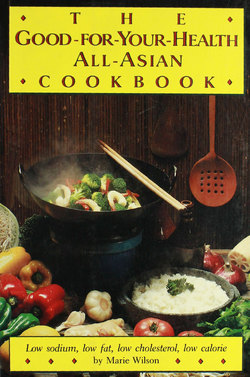Читать книгу Good for Your Health All Asian Cookbook (P) - Marie Wilson - Страница 8
На сайте Литреса книга снята с продажи.
ОглавлениеPreface
When I wrote Siamese Cookery more than twenty years ago, I was blissfully ignorant of the hazards of too much fat, cholesterol, and sodium in the diet. Having spent many years in Thailand, I was addicted to all the mouth-watering foods of the area, especially, the salty sauces and the deep-fried dishes. Monosodium glutamate had a niche next to my salt shaker, and I used soy sauce, fish sauces, and Chinese condiments liberally. I also loved eggs, steak, butter, cream-rich desserts, and especially French cheeses. I had the best of both worlds, and, insofar as good health is concerned, the worst.
I fear this may be happening to affluent Japanese in Japan today. To their salty diet they are adding the West's penchant for beef, cream, butter, and eggs. The trend is noteworthy enough to make news in the American press. An article from the New York Times describes exquisite French-inspired pastries by Yukio Sakase available at a Japanese pastry shop in Tokyo. His green-tea genoise contained four whole eggs and one egg yolk and his green-tea mousse, one cup of heavy cream. They were described as "maintaining the incomparable softness of the genoise and the silken airiness of mousse and Bavarian cream." I'm sure that if I were in Japan today I. would have a difficult time resisting such tantalizing temptations.
My purpose in writing this book was to prove that it is possible to prepare conspicuously delicious Asian dishes without the use of salt. It proved to be an enormous challenge, but the variety of seasonings and exotic flavorings that these countries have to offer can not only substitute for the taste for salt but also overcome the need for it. What follows is a collection of recipes for lovers of Asian foods who are seeking better health without sacrificing the pleasures of good eating. I hope also to appeal to those who are not familiar with Asian foods but who watch their diets and wish to enlarge their repertory of good-tasting recipes that are low in fat, sodium, and cholesterol. My concern is lowering the risk for heart disease, high blood pressure, and cancer—to the extent that such a diet can do so—by eating good-tasting and attractive foods.
I go on the assumption that if the food doesn't taste good, the chances are excellent that the diet, and the good intentions behind it, will disappear within a short time. The principles and guidelines I have followed are recommended by the American Heart Association, the National Academy of Sciences, and other leading medical authorities.
I have selected only those dishes that could be satisfactorily adapted to remain as good tasting as the originals. Very little fat is used in their preparation, and salt and monosodium glutamate have been wholly forsaken. In their place stand those miracles of flavor and aroma: garlic, fresh ginger root, spices, and herbs to add zest and pungency; pepper, chilies, horseradish, and mustard powder for those who like food hot; and wine, lemon juice, vinegar, and sugar for a sweet-and-sour touch. All these ingredients can spark foods to new taste pleasures without the need for salt. Keep in mind that it took a lifetime to acquire this taste for salt and salty condiments, so you cannot expect to change it overnight. If you cut back a little at a time, your taste buds will gradually become so used to savoring other flavors that some foods and seasonings that were once craved and found palatable will seem intolerably salty and wholly inedible.
—Marie Wilson
